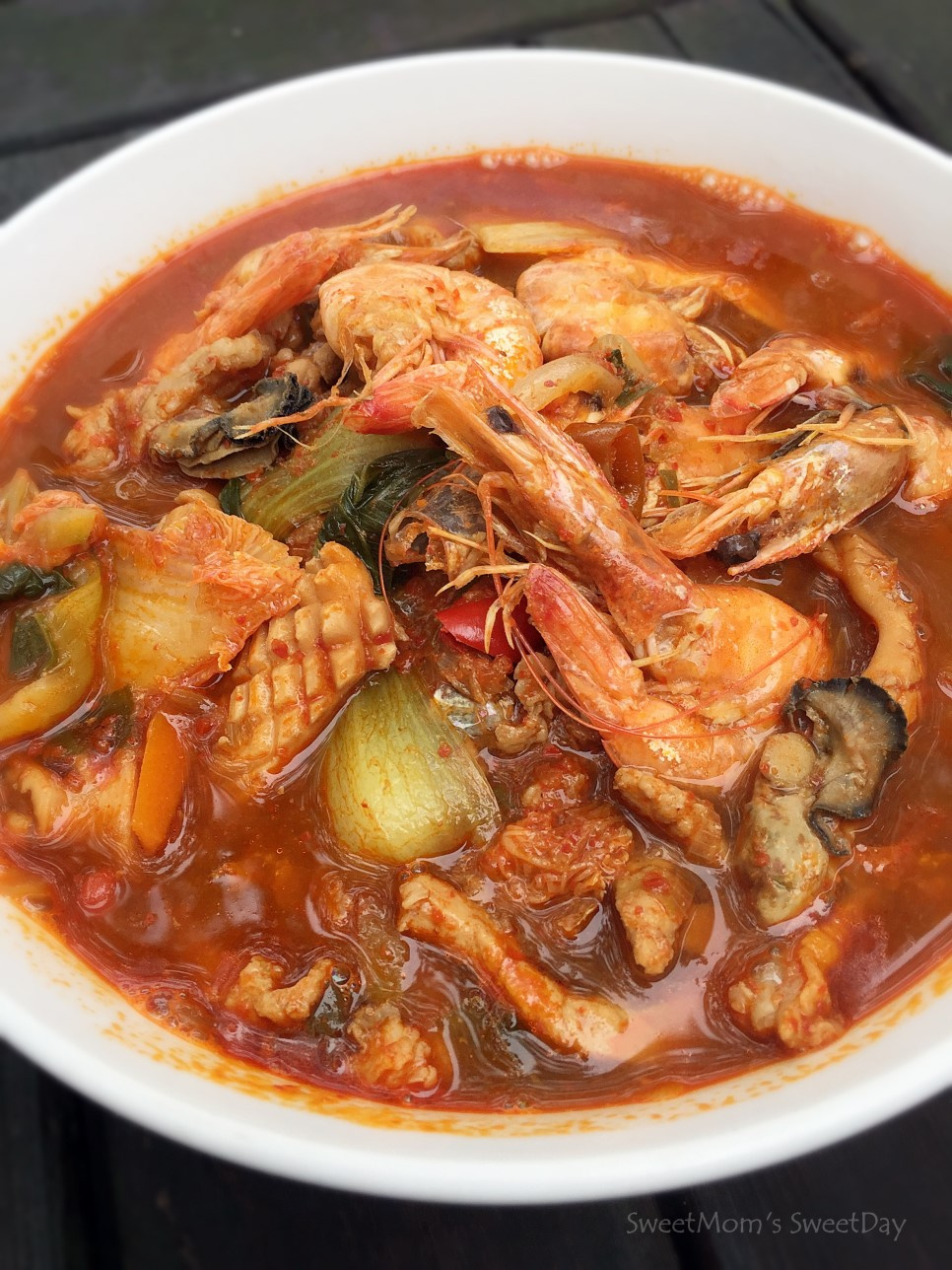Spicy and Refreshing Jjamppong: A Hearty Homemade Noodle Soup
Autumn Vibes: Easy and Flavorful Jjamppong Recipe

As the beautiful autumn foliage begins to paint our surroundings, the crisp fall breeze makes us crave warm, comforting soup dishes. Today, I’ve made Jjamppong, a perfect dish for this season, brimming with an abundance of seafood and vegetables. Enjoy the cozy autumn season with this Jjamppong, featuring a deep and rich broth that’s simply divine!
Seafood and Meat- 1 large squid
- 14 medium shrimp
- 10 oysters
- 2 cups thinly sliced pork
Flavorful Seasonings- 1/2 cup cooking oil (approx. 120ml)
- 2 cups chopped green onion (approx. 200g)
- 1 Tbsp minced ginger
- 6 Tbsp soy sauce
- 6 Tbsp red pepper flakes (gochugaru)
- 2 Tbsp fish sauce (or anchovy sauce)
- Pinch of black pepper (optional)
- Pinch of salt (for seasoning adjustment)
Crisp Vegetables- 1 large onion (thickly sliced)
- 6 napa cabbage leaves
- 1 cup shredded carrot
- 2 heads bok choy
- 2 cups sliced zucchini
- 1 handful of chili peppers (optional, for extra spiciness)
Noodles or Rice (Your Choice)- 4 servings of store-bought Jjajang Udon noodles
- 4 bowls of cooked rice
- 1/2 cup cooking oil (approx. 120ml)
- 2 cups chopped green onion (approx. 200g)
- 1 Tbsp minced ginger
- 6 Tbsp soy sauce
- 6 Tbsp red pepper flakes (gochugaru)
- 2 Tbsp fish sauce (or anchovy sauce)
- Pinch of black pepper (optional)
- Pinch of salt (for seasoning adjustment)
Crisp Vegetables- 1 large onion (thickly sliced)
- 6 napa cabbage leaves
- 1 cup shredded carrot
- 2 heads bok choy
- 2 cups sliced zucchini
- 1 handful of chili peppers (optional, for extra spiciness)
Noodles or Rice (Your Choice)- 4 servings of store-bought Jjajang Udon noodles
- 4 bowls of cooked rice
- 4 servings of store-bought Jjajang Udon noodles
- 4 bowls of cooked rice
Cooking Instructions
Step 1
In a deep pot, heat 1/2 cup (approx. 120ml) of cooking oil. Add 2 cups (approx. 200g) of chopped green onions and 1 Tbsp of minced ginger. Gently sauté over low heat until fragrant and lightly golden, creating a flavorful scallion oil. Be careful not to burn the scallions, as this will add a delicious depth of flavor.

Step 2
Once the aroma of the scallion oil is released, add 2 cups of thinly sliced pork. Stir-fry over medium heat until the pork is browned and cooked through, infusing it with a savory wok hei flavor.

Step 3
When the pork is almost cooked, add 1 large squid, cleaned and cut into bite-sized pieces (about 1-2 cm wide). Stir-fry briefly with the pork. It’s important not to overcook the squid, as it can become tough. Just cook until it’s almost done.

Step 4
Now, it’s time to add the seasonings that will create the signature spicy flavor of Jjamppong. Pour in 6 Tbsp of soy sauce,

Step 5
add 6 Tbsp of gochugaru (red pepper flakes),

Step 6
and then add 2 Tbsp of fish sauce (or anchovy sauce) for an extra layer of umami.

Step 7
Stir-fry everything together over medium heat until the ingredients and seasonings are well combined. Be cautious not to burn the gochugaru, as this can result in a bitter taste. Continue to stir-fry until the squid is about half-cooked.

Step 8
It’s time to add the fresh vegetables. Add 1 large onion (thickly sliced), 6 napa cabbage leaves, 1 cup of shredded carrot, 2 heads of bok choy (cleaned), and 2 cups of sliced zucchini.

Step 9
Increase the heat to high and stir-fry quickly until the vegetables are slightly softened but still retain a slight crispness. Preserving the fresh taste of the vegetables is key.

Step 10
Once the vegetables have been stir-fried and softened slightly,

Step 11
pour in 11 cups of water (200ml per cup) or 11 cups of a refreshing anchovy broth. Bring to a boil over high heat. Using broth will add even more depth and richness to your soup.

Step 12
Prepare the shrimp by deveining them using a toothpick inserted under the second segment of their backs. Clean the oysters (or mussels) thoroughly. Properly cleaning the seafood is crucial for a delicious, non-fishy taste.

Step 13
Once the broth is boiling vigorously, carefully add the prepared shrimp and oysters (or mussels). Avoid overcooking the seafood, as it can become tough. Remove them from the pot as soon as they are cooked or reduce the heat.

Step 14
When the seafood has released its delicious juices and the broth becomes savory and refreshing, turn off the heat. If you desire more spiciness, you can add a handful of chili peppers at this stage. Finally, add a pinch of black pepper to taste for extra aroma. Adjust the seasoning with salt if necessary.

Step 15
Cook the store-bought Jjajang Udon noodles according to the package directions. Drain and rinse them under cold water. Place the cooked noodles in a serving bowl, and generously top with the Jjamppong ingredients.

Step 16
Finally, ladle the hot and flavorful Jjamppong broth generously over the noodles.

Step 17
Your Jjamppong is now complete! It’s hot, spicy, and perfectly balanced with the refreshing taste of seafood and the savory notes of the vegetables. You can enjoy a Jjamppong that rivals your favorite restaurant, right in your own home.

Step 18
Why not treat yourself to a warm and delicious bowl of Jjamppong for dinner tonight? Come on over for a taste!



